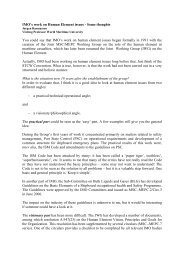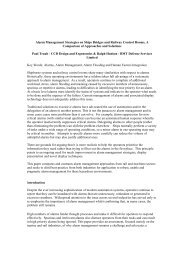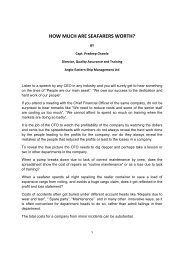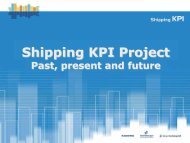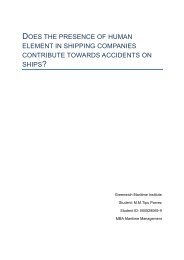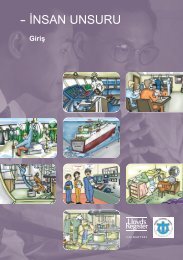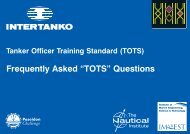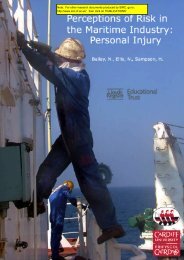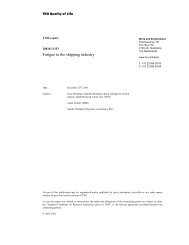Download PDF - Alert!
Download PDF - Alert!
Download PDF - Alert!
You also want an ePaper? Increase the reach of your titles
YUMPU automatically turns print PDFs into web optimized ePapers that Google loves.
human element can be systematically addressed in<br />
the design and construction of ships and ship<br />
systems.<br />
2. THE APPLICATION OF ERGONOMICS TO SHIP<br />
DESIGN<br />
This section examines the ship life cycle and how it<br />
shapes the application of ergonomics. The industry<br />
has a unique life cycle, and this presents a number of<br />
challenges to successful ergonomic design.<br />
The management of ships is a very old skill. There is<br />
an almost unique management structure (e.g. ships<br />
are required to behave as autonomous, selfpreserving<br />
entities for long periods, the safest way of<br />
handling a ship often requires seafarers to take<br />
immediate and unquestioning action in response to<br />
commands, etc.). Tradition relating to the marine<br />
context is very strong. Knowledge, responsibility and<br />
authority are defined by this tradition. New systems<br />
and ways of working have to be introduced carefully.<br />
In many cases this is not done in a sympathetic way,<br />
leading to inefficiencies or sources of error. In<br />
particular introduction of technology and reduction in<br />
manning do not take account of responsibility and<br />
human competence, capabilities and limitations (e.g.<br />
fatigue and stress) or available procedures and<br />
resources.<br />
The seafaring culture is complex involving maritime<br />
traditions, complex personal motivations, and<br />
multilingual, multi-cultural crews. National culture has<br />
a strong influence, especially in senior operational<br />
and engineering roles. Problem solving, conformance<br />
to procedures, perception of risk and response to<br />
emergencies are all influenced by cultural issues.<br />
However, systems development and support rarely<br />
takes account of these issues. Risks are thereby built<br />
into system operation.<br />
Beyond regulatory needs the requirements for the<br />
construction and maintenance of ships and<br />
associated equipment are defined in part in<br />
international standards but primarily in Class Rules.<br />
The marine industry is highly competitive and costs<br />
are tightly controlled. The minimum number of<br />
suitably skilled staff is employed at sea and ashore<br />
and the majority of efficiency improvements have<br />
already been made.<br />
2.1 THROUGH-LIFE CONSIDERATIONS<br />
A challenge to Human Factors Integration (HFI) in a<br />
number of industries is that costs and benefits are<br />
split across stakeholders. Paying more at the design<br />
stage for a benefit during the operational stage needs<br />
someone to fund through-life considerations. This<br />
applies in the maritime industry in a particular way. It<br />
is also the case that there is a significant commercial<br />
and regulatory gap between design and operation;<br />
successful ergonomics requires bridging this gap.<br />
“The requirements for a ship rarely indicate the<br />
relative importance that the owner attaches to<br />
operating economy and first cost, although this<br />
should be an important design consideration”<br />
[Watson, 2002]. The focus during design is on the<br />
needs of construction; product breakdown structures<br />
are based on manufacturing requirements, which do<br />
not lend themselves to operational considerations.<br />
A ship may have several owners or operators in its<br />
life. The systems will either be a standard design or<br />
will (more or less) have been specified for a particular<br />
crew and operational concept (explicitly in the<br />
invitation to tender or implicitly through assumptions<br />
in design and modifications in use). The context of<br />
use introduced by subsequent operators may<br />
introduce hazards such as change of working<br />
language, assumptions about roles and training,<br />
assumed operating and maintenance procedures.<br />
Some owners see ships as a tradable asset rather<br />
than as complex, mobile, sociotechnical entities, and<br />
as a consequence have no incentive to invest in<br />
through-life considerations.<br />
Crew costs are seen as an area where economies<br />
can be made. “A reduction of one in the number of<br />
engine room staff may reduce running costs by as<br />
much as, or more than, can be achieved by<br />
expensive improvements in engine efficiency”<br />
[Watson, 2002]. Cost reduction is attempted by<br />
increasing working hours, reducing the use of skilled<br />
crew, recruitment from developing countries, etc. The<br />
consequent requirements on system dependability<br />
are not in general recognised.<br />
Systems used in the marine environment tend to be<br />
"fit and forget" and may be used for the life of the ship<br />
(nowadays around 25 years but may be up to 35) or<br />
at least on a ten to 15 year refit cycle. Whilst this is<br />
not a problem for most mechanical systems, it is<br />
pushing the design lifetime for many components in<br />
electrical or electronic systems, and is many times<br />
the design life of IT systems. In operation date<br />
handling errors, obsolete data storage media,<br />
component availability and software maintenance are<br />
all potential problems. Typical problems for systems<br />
refresh include lack of design for replacement (e.g.<br />
access to cables), availability of bandwidth, access,<br />
use of non-standard interfaces, capture and use of<br />
knowledge from operation in the new specification.<br />
3




